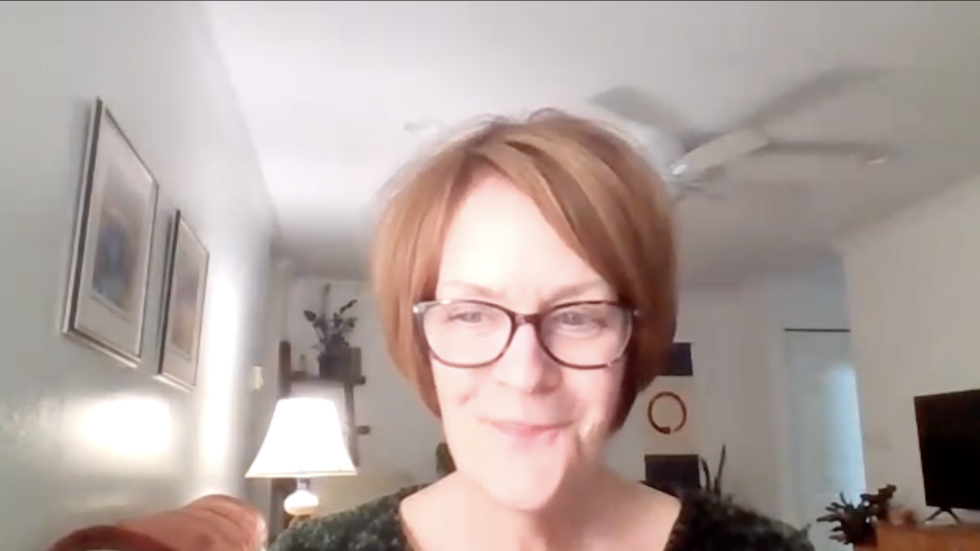
Cultivating gratitude
The holidays can be stressful and it can be easy to lose yourself in the excitement of gathering, chaos of preparations and travel, or a sense of loneliness and loss for some. Senior mindfulness instructor reflects on gratitude and offers practices to ease into this season with a mindful heart.
The other morning, I was feeling a bit sad about not being able to travel and spend the upcoming Thanksgiving holiday with my family. I decided to go for a run on the bike path that runs along the river near where I live.
I knew that getting some fresh air and physical activity would be helpful. The sun had recently risen, the air was crisp and still, and the river was like glass. I was enjoying the silence and stillness of the morning when suddenly up ahead I heard loud construction type noises.
“What is this, so early in the morning?” I wondered, with more than a touch of annoyance. Up ahead on the path, I noticed the sound was coming from workers. They appeared to be using a chainsaw. As I approached, I could see that a tree had fallen, apparently during the night, and the crew was hard at work to clear the path.
“You’re at it early,” I offered. One of the workers smiled and said yes, they were alerted about the fallen tree and wanted to clear the path as soon as possible, knowing that many use it for morning walks, including commutes to work. “Thank you,” I said as I continued my way.
A few moments later a biker rode by heading towards the newly cleared path. Then I passed a couple pushing a stroller that held their child. A smile came to my face as I realized that we all are now able to continue with our morning walks without having to navigate around a fallen tree.
“Thank you,” I said again, now silently to myself, feeling genuine appreciation for the workers clearing the path on a cold early morning so others could use it safely. Any trace of sadness was gone, replaced with gratitude for the company I was keeping as I ran along this much loved, and cared for bike path.
Gratitude is good medicine
At this time of year, here in the United States, we are approaching the Thanksgiving holiday – a time when we acknowledge and express what we’re grateful for. What exactly is gratitude, and well, what good is it?
Robert Emmons, Professor of psychology at the University of California, Davis is considered one of the world’s leading experts on the science of gratitude. He defines gratitude as having two parts. First, it is an affirmation of goodness. We can become aware of and affirm that there are good things in the world, gifts and benefits we have received. And, there is recognition that the source of this goodness lies outside of oneself – that we receive gifts from other people, from a higher power if this is a belief you hold. From the natural world, Professor Emmons views gratitude as a relationship-strengthening emotion because it requires us to see how we’ve been supported and affirmed by other people.1
And according to Emmons, gratitude is good medicine.
The benefits of gratitude
There is a growing body of research showing that practicing gratitude has social, physical and psychological benefits – even in the midst of adversity. Gratitude can help to improve sleep, lower blood pressure and incline a person towards more health-conscious choices.2 Gratitude contributes to happiness.3;4 Gratitude helps improve relationships with friends5 and fosters a healthy social circle.6
Practicing gratitude can be difficult, especially when we are aware of the vast amount of suffering, inequality, injustice and meaness that seems so prevalent in our world. Not to mention the marketing we are bombarded with around this time of year that seems more focused on “Black Friday,” encouraging us to rush out and get more stuff than we and others may or may not need, at the supposed best deals possible.
So similar to loving kindness and other qualities and virtues that support a life well lived, not just for ourselves, but for the good of all, gratitude is – thankfully – something that we can cultivate.
We can set aside time to consciously practice gratitude, inviting it to grow and take root within us.
Watch the recorded webinar:
 Play
Play
In this webinar, we explore gratitude. The holidays can be stressful and it can be easy to lose yourself in the excitement of gathering, chaos of preparations and travel, or a sense of loneliness and loss for some. Wherever you fall on this spectrum, ease into this season with a mindfulness practice of gratitude.
Prompts for your own exploration:
3 ways to integrate an intentional gratitude practice into your day
1. Keep a gratitude journal
This can be a simple listing done daily or a few times during the week. Writing can be helpful. It slows us down, allowing us to reflect more deliberately. Be specific, this can deepen our experience of gratitude.
If you’d like to explore more in depth what you may be grateful for, Joel Wang, Professor of counseling psychology at Indiana University’s School of Education created a list of 100 questions that may serve as useful prompts to reflect on and journal. He shares that the benefits of gratitude activities unfold through long-term habits. Try linking gratitude practice to an already ingrained routine. For example, think about what you’re grateful for at a regular time, maybe while sipping your morning coffee or tea, or as part of a winding down routine as you prepare for sleep.
2. Savor moments of gratitude
As you reflect on what you are grateful for, or notice yourself feeling grateful, take a moment and pause. Draw attention to your inner experience. What do you feel in your body? Allow the felt sense of gratitude to be known and experienced. Savor this for 15 seconds, let it really sink in.
In their book Mindfulness: Finding Peace in a Frantic World, Mark Williams and Danny Penman recommend the practice of appreciating here and now. They remind us that life only happens here, in this moment. Practice bringing appreciative attention for the here and how. Become still and look around. How is the “now” for you?
What activities, things or people in your life make you feel good? Can you give additional appreciative attention and time to these activities? Make a list. Then, be aware as you go about your day when you encounter these. Take a moment and offer appreciative attention.
3. Try the ten-finger gratitude exercise
This is another practice Williams and Penman suggest. The Ten-finger Gratitude Exercise can support and foster a positive appreciation for the small things in your life. Once a day, bring to mind ten things that you are grateful for, counting them on your fingers. It’s important to come to ten things, even when it feels difficult after you’ve identified 3 or 4.
During this, and all times of the year, I wish you well. May you know peace. May there be ease as you go about your day.
Thank you, truly.
Deepen Your Mindfulness Practice
In collaboration with the Mindfulness Center at Brown, the School of Professional Studies provides a variety of programs for newcomers, seasoned practitioners and teachers in-training.
1Emmons, R. (2010, November 16). Why gratitude is good. The Greater Good Science Center at the University of California, Berkeley. Retrieved November 2023.
2Emmons, R. A., & McCullough, M. E. (2003). Counting blessings versus burdens: An experimental investigation of gratitude and subjective well-being in daily life. Journal of Personality and Social Psychology, 84(2), 377-389. https://doi.org/10.1037/0022-3514.84.2.377
3Emmons, R. A., & McCullough, M. E. (2003). Counting blessings versus burdens: An experimental investigation of gratitude and subjective well-being in daily life. Journal of Personality and Social Psychology, 84(2), 377-389. https://doi.org/10.1037/0022-3514.84.2.377
4Seligman, M. E., Steen, T. A., Park, N., & Peterson, C. (2005). Positive psychology progress: Empirical validation of interventions. American Psychologist, 60(5), 410-421. https://doi.org/10.1037/0003-066x.60.5.410
5Lambert, N. M., & Fincham, F. D. (2011). Expressing gratitude to a partner leads to more relationship maintenance behavior. Emotion, 11(1), 52-60. https://doi.org/10.1037/a0021557
6Wood, A. M., Froh, J. J., & Geraghty, A. W. (2010). Gratitude and well-being: A review and theoretical integration. Clinical Psychology Review, 30(7), 890-905. https://doi.org/10.1016/j.cpr.2010.03.005